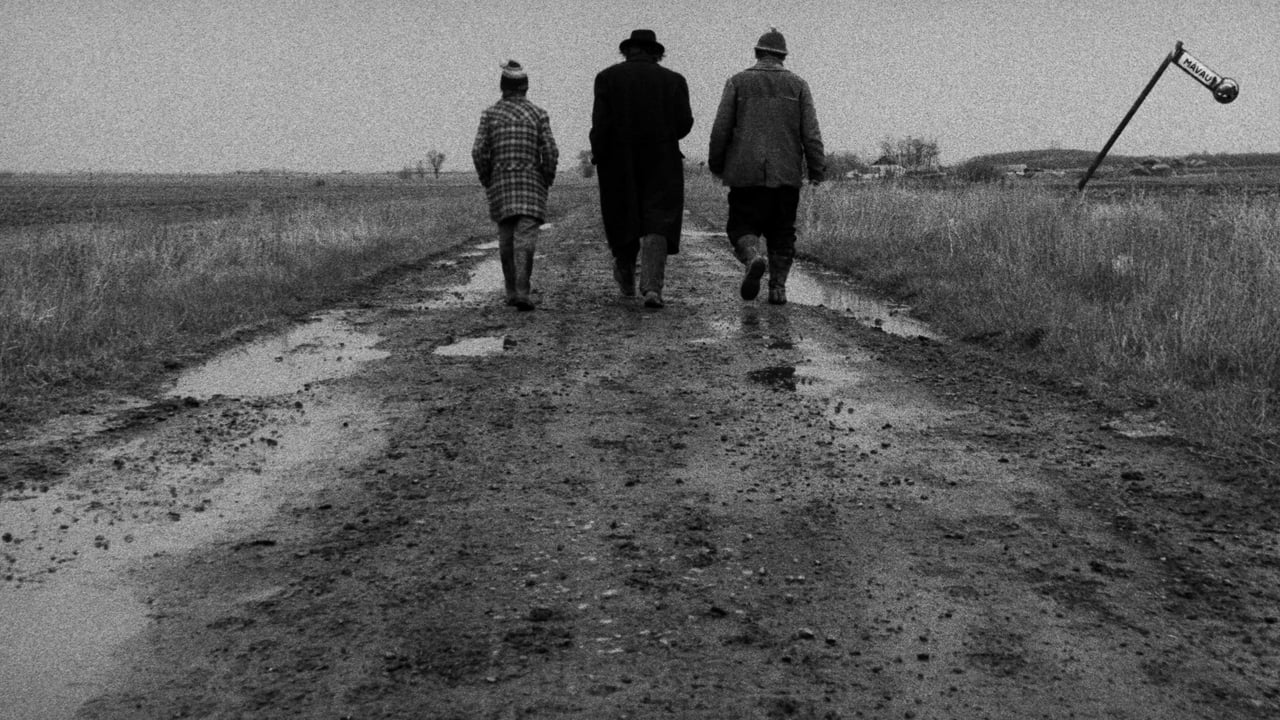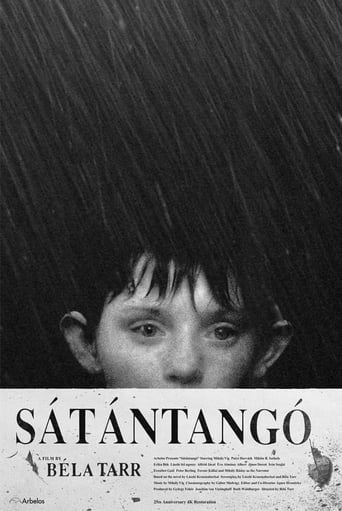



This movie was so-so. It had it's moments, but wasn't the greatest.
View MoreWhen a movie has you begging for it to end not even half way through it's pure crap. We've all seen this movie and this characters millions of times, nothing new in it. Don't waste your time.
View MoreIt's the kind of movie you'll want to see a second time with someone who hasn't seen it yet, to remember what it was like to watch it for the first time.
View MoreThe acting in this movie is really good.
What is it, where is it, how will it affect me? A seven hour long documentary-style study of a closely-knit and decadent rural life in Hungary using a group of fictional misfits and an abandoned, isolated machinery plant as the medium. Why? That's really quite an essential question regarding Sátántangó, despite the fact that you might not realise it quite yet. Why did this film happen? As Nick Pinkerton of Village Voice accurately pointed out: its seven hour runtime is unattractive and impractical to prospective viewers, ipso facto the one-screening-a-day bulk structure defies profit motive and its characters, proclaimed 'poor, ugly, sad and damned people' deny expectations of pleasure. So, why? By process of elimination upon pre-viewing research: to make a statement, and after viewing: obsession. Such a transition of outlook opens new avenues for filmmakers and audiences to explore the two most important parameters that structure the medium: space and time. An accomplishment with such calibre is worthy of considerable attention and acclaim. Now everybody is sitting comfortably, I can give Sátántangó my share. Drunken amounts of synergy emerge from the screenplay of this film, which redefines the phrase 'the whole is greater than the sum of its parts'. Its effect is puzzling but as sincerely lifting as the finest of wines. What does spring to mind, of all things, is a young Ludwig Wittgenstein and his theory of 'language games'. In his work, he writes of an attitude towards faith and trust in God, and how those who take part in this 'game' will be able to understand the specific, exclusive language used within it and be rewarded eschatologically (after death). A similar attitude, although sometimes difficult and certainly impractical, if taken toward Sátántangó, yields equal bounty cometh the close of the seven and a half hours of slow, drunkenly beautiful meandering shots and marmite characters both bickering and caring amongst and for each other. Cometh the close, I felt many things: relief, depression, for all I can concentrate: Stockholm Syndrome (after being locked in with a set of the most flamboyant lovable and hateable characters I've ever seen) and scepticism to whether European cinema could ever match the immaculate and painstakingly poured over directing of Sátántangó during my lifetime. To see being invoked within me such a reaction from a single piece of artwork was giddy. It's a film with a stature and a reputation about it, one too leviathan to be shunned, one too long and that requires too much of a commitment to slander for no good reason. Sátántangó, the 1990s golden seal of artistic merit and power amidst claptrap crime spin-offs and rushed all-American 'masterpieces', is something of almighty reward and calibre that sits sentinel and humble in the face of those it will influence and the audience that it shall seduce and accept as one of its own.
View MoreIf you agree with the following statement, then read on; otherwise skip my entire review.The torturing/killing of living things is NEVER justified if the reason is "for entertainment", or worse, "for art".Good, you're still here which means there's hope for the human race. SATANTANGO features a scene where a real cat is shaken, flipped around, rolled in the dirt, rolled over, shaken again, stuck in a bag and hung on a wall. The torture lasts about 10 minutes and can be seen on Youtube by searching "Satantango cat".Not all countries have animal protection laws, and not all directors respect animal life. Oddly enough, it's often the "enlightened", well-respected filmmakers who are the worst offenders. Watch out for Tarr (Satantango - cat tortured), Tarkovsky (Andrei Rublov - cow lit on fire, horse shot and thrown down stairs), Herzog (Even Dwarfs Started Small - monkey crucified, chickens thrown through window), Von Trier (Manderlay - donkey slaughtered), Coppola (Apocalypse Now - water buffalo partially decapitated), Ki Duk Kim (where to begin?), and the list goes on. You can check all my 1 star reviews for more.To all of the above films I say no thank you, just as I'd prefer not to cheer at a bullfight or adore a Nazi lamp made of human flesh, no matter how "beautiful". I'll stick to directors who show sensitivity and compassion, in front of the lens as well as behind it: Kurosawa, Wenders, Jarmusch, Anno, there are plenty enough films to keep me busy.
View Moreit would be about time that so-called "artistic" goals stopped being achieved by using animal turture. This movie uses this little "nice" trick and every time i see that in movies i think: is it REALLY needed it? does it REALLY add value to the movie? but especially, i think: what is wrong with Bela Tarr and all those directors who speculate on the lives of animals for a movie's sake? And btw im not a PETA guy... What is wrong with all you people giving 10 stars to this marathon of stale cinema? It's true that the movie has something appreciable and quite rare to find compared to what can be found by the average movies nowadays, but I also think after reading most of the comments. it's been WAY WAY WAY OVERVALUED..FAR FROM A MASTERPIECE... Let's face it.. all that length was not necessary... 5 in my opinion.
View MoreI was familiar with Tarr's "Harmonies of Werkmeister", but i think there is noway that they match this unprecedented masterpiece! Take 7 hours of your lifetime and watch the film, not a single minute is needless! Perfect cinematography, pace, music, photography. Acting was flawless and i think that many of the actors were amateurs. The whole child's episode offered one of the most moving performances in the history of cinema! Tarkovsky sure is an influence for Tarr. While watching it the only scene that seemed needless was the Doctor-episode, but the end of the film put the things in order - or not? Nothing less than an heroic feat in the history of cinema! Right from the famous opening scene i was mesmerized. Cyclical time is the main subject of this movie (others are human seek for purpose, truth, religion) based on a Hungarian novel and i think that a basic key to try to grasp this movie's meaning is the art of intellectual creation trying to alter or transcend time and space (novel in a novel - movie in a movie). I'm going to watch "Damnation", as soon as I find the just position for Satantango in my top 10 movie list of all time, why not contesting my number 1, which is of course "Citizen Cane".
View More